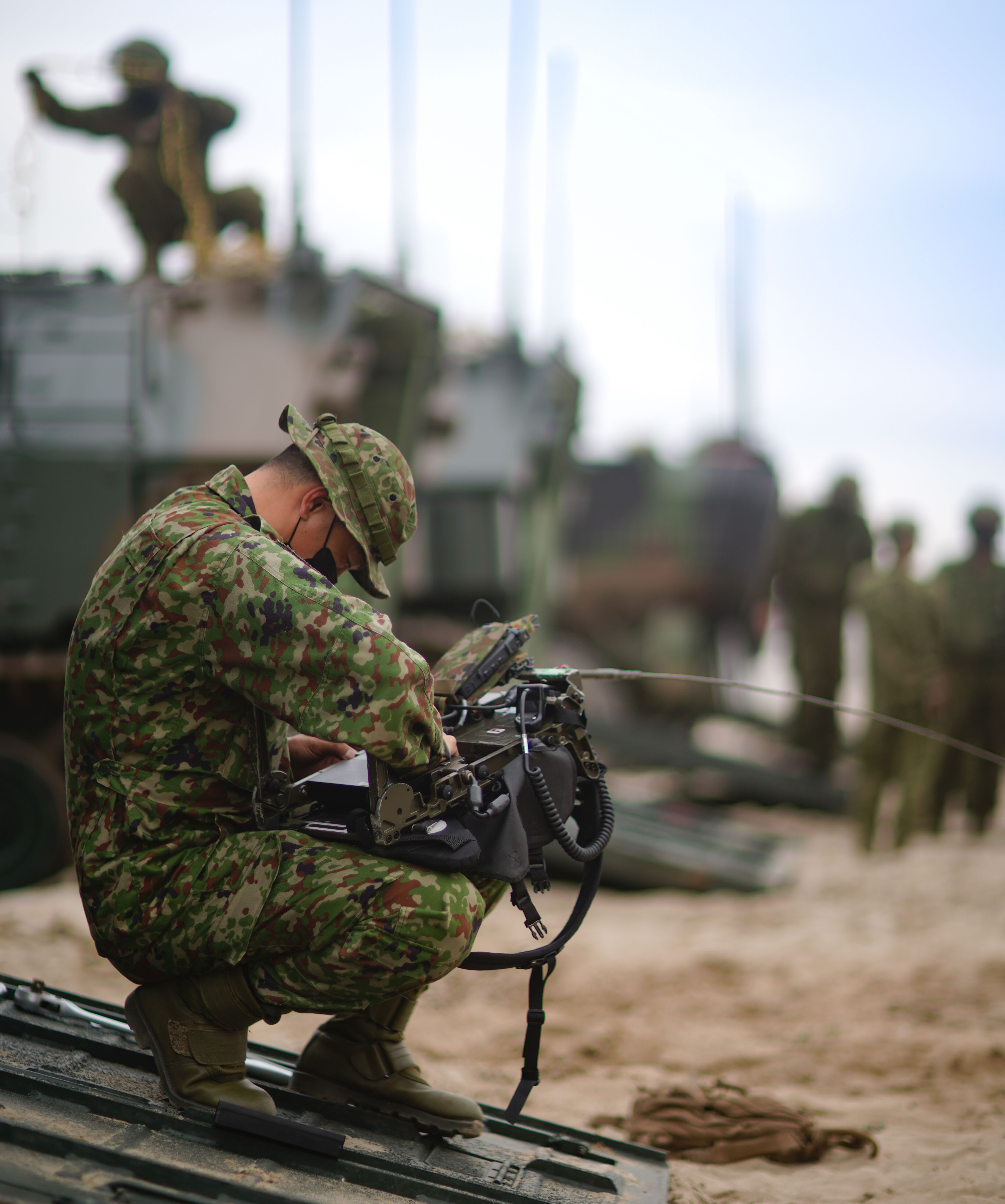
The Japan Ground Self-Defense Force last week formally activated the 3rd Regiment of its Amphibious Rapid Deployment Brigade, a key element of Japan’s plan to defend its southwest region and the outlying islands there. Last month Japan also stood up a JGSDF electronic warfare unit on Yonaguni Island and a surface-to surface-missile unit on Okinawa – the first time this type of unit has deployed on Okinawa.
The regiment was activated at Camp Takematsu, Nagasaki, on the main island of Kyushu. Defense Minister Minoru Kihara, who presented the regimental flag to its commanding officer, Col. Takada, attended the ceremony. In a press conference, Kihara said defending Japan’s various remote islands is crucial to the country’s existence, given the large number of islands.
The Japanese defense chief also said the establishment of the 3rd ARDB regiment and the recent deployment of an electronic warfare unit to Yonaguni Island would strengthen Japan’s ability to defend the Nansei Islands and the electromagnetic domain “and will demonstrate Japan’s intention not to allow unilateral changes in the status quo by force, and will enhance our deterrence and response capabilities.”
He said China has been rapidly strengthening its military power both in quantity and quality in recent years, citing a recent example of a People’s Liberation Army Navy frigate that had been active south of the Nansei Islands for about two weeks. PLAN frigates CNS Zhoushan (529) and CNS Jingzhou (532) were cruising in an area 111 miles south of Ishigaki Island to 130 miles southeast of Miyako Island from Mar. 3–14, Japan’s Joint Staff Office (JSO) reported on Mar. 18.
Japan has prioritized the defense of the southwest regions and its various islands, which include the disputed Senkaku Islands, held by Japan and claimed by both China and Taiwan. PLAN ships, including the Liaoning and Shandong Carrier Strike Groups, have routinely operated in international waters around the southwest region and transited international waters there.
In regard to the ARDB, Kihara said that with the establishment of the 3rd Regiment, the brigade will now be able to rotate its regiments between training, including overseas training deployments, maintenance and a standby ready deployable regiment for any event. The ARDB consists of three regiments, a brigade headquarters, support battalions and companies for a total of around 3,300 personnel. Kihara said there were no plans to further expand the ARDB.
The ARDB’s completion shows the priority the JGSDF is placing on warfighting capability, retired U.S. Marine Col. Grant Newsham, a senior research fellow at the Japan Forum for Strategic Studies, told USNI News.
“The ARDB’s location down in Kyushu at the northern end of the Nansei Shoto is where Japan faces its greatest threat – from the PRC – and the ARBD is intended and configured to operate in a maritime environment which is where the fight will happen,” said Newsham, who was previously the Marine Corps’ first liaison officer to the JGSDF and was involved with establishing the ARDB.
The ARDB is also where the Japan Self-Defense Force as a whole and the JGSDF are enhancing the capability to conduct combined/joint operations with the Japan Maritime Self-Defense Force and Japan Air Self-Defense Force. These operations have been a shortcoming in Japan’s military for many years, according to Newsham, who added that the ARDB operates easily enough with U.S. forces and other major partners.
During his press conference, Kihara outlined Japan’s current plans for defending the southwest region, stating that JGSDF units have already deployed to Yonaguni Island, Amami Oshima, Miyako Island and Ishigaki Island. On Thursday, a surface-to-ship guided-missile unit was newly established at the Katsuren subcamp on Okinawa, he noted, adding that this year, a surface-to-ship guided-missile unit is scheduled to deploy to Camp Yufuin in Oita Prefecture on the main island of Kyushu. The Ministry of Defense is also planning to establish the Saga Camp, from which the V-22 Osprey and other aircraft will deploy. The 15th Brigade in Okinawa will expand to a division and the current single infantry regiment increased to two based on the Defense Force Development Plan, according to the Japanese defense chief.
Kihara also said the Ministry of Defense plans to strengthen military facilities in the region, including moving the command centers at JASDF Tsuiki Air Base and JASDF Nyutabaru Air Base – both located on the main island of Kyushu – underground.
In an announcement on Mar. 21, JGSDF Chief of Staff Gen. Yasunori Morishita stated that the 7th Surface-to-Ship Missile Regiment was established and the Western Area Special Forces has been reorganized into the 2nd Special Forces Group to strengthen deterrence and response capabilities related to the defense of islands in the southwest region. The JGSDF Chief did not say where the regiment is located, but this was clearly in reference to the unit stood up at Okinawa that day.





